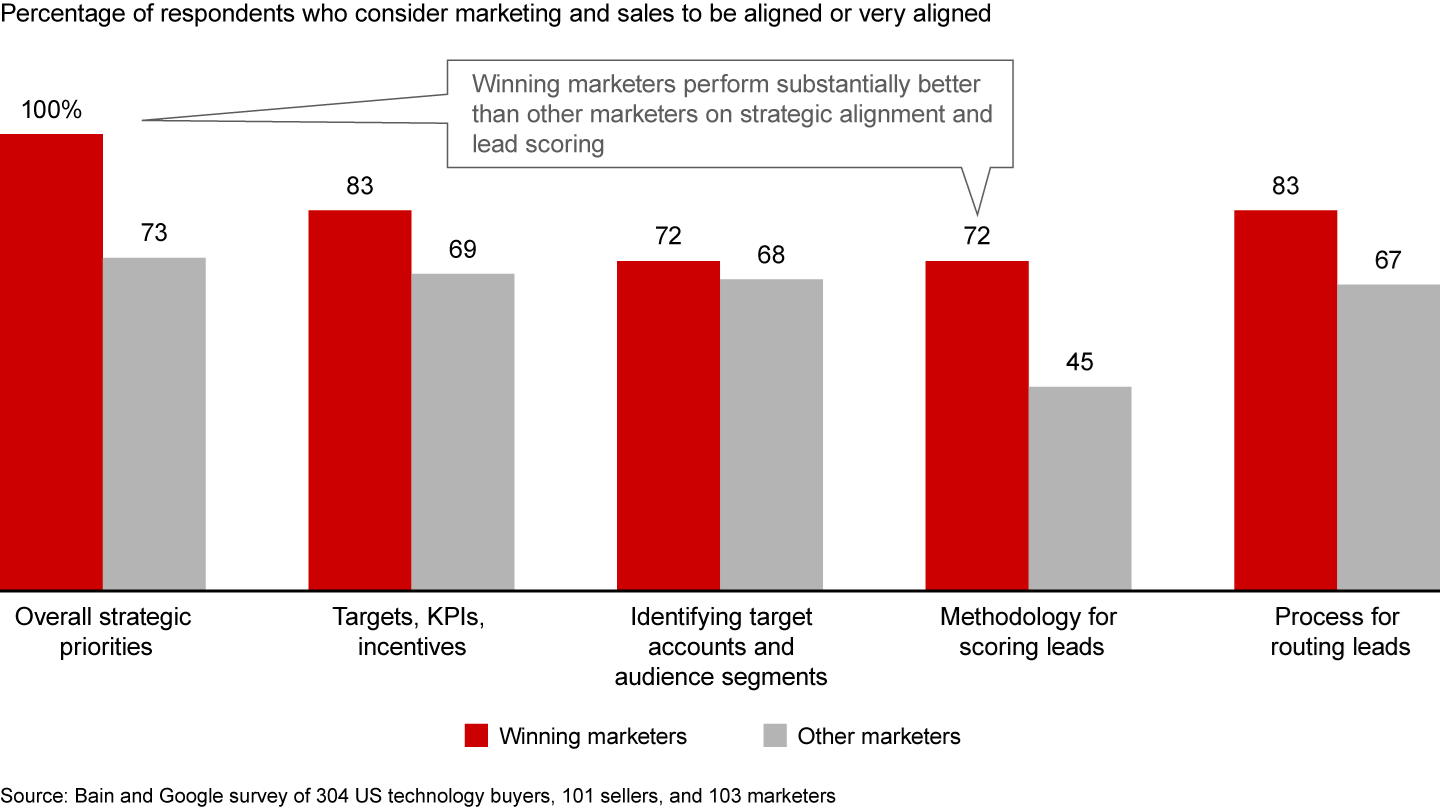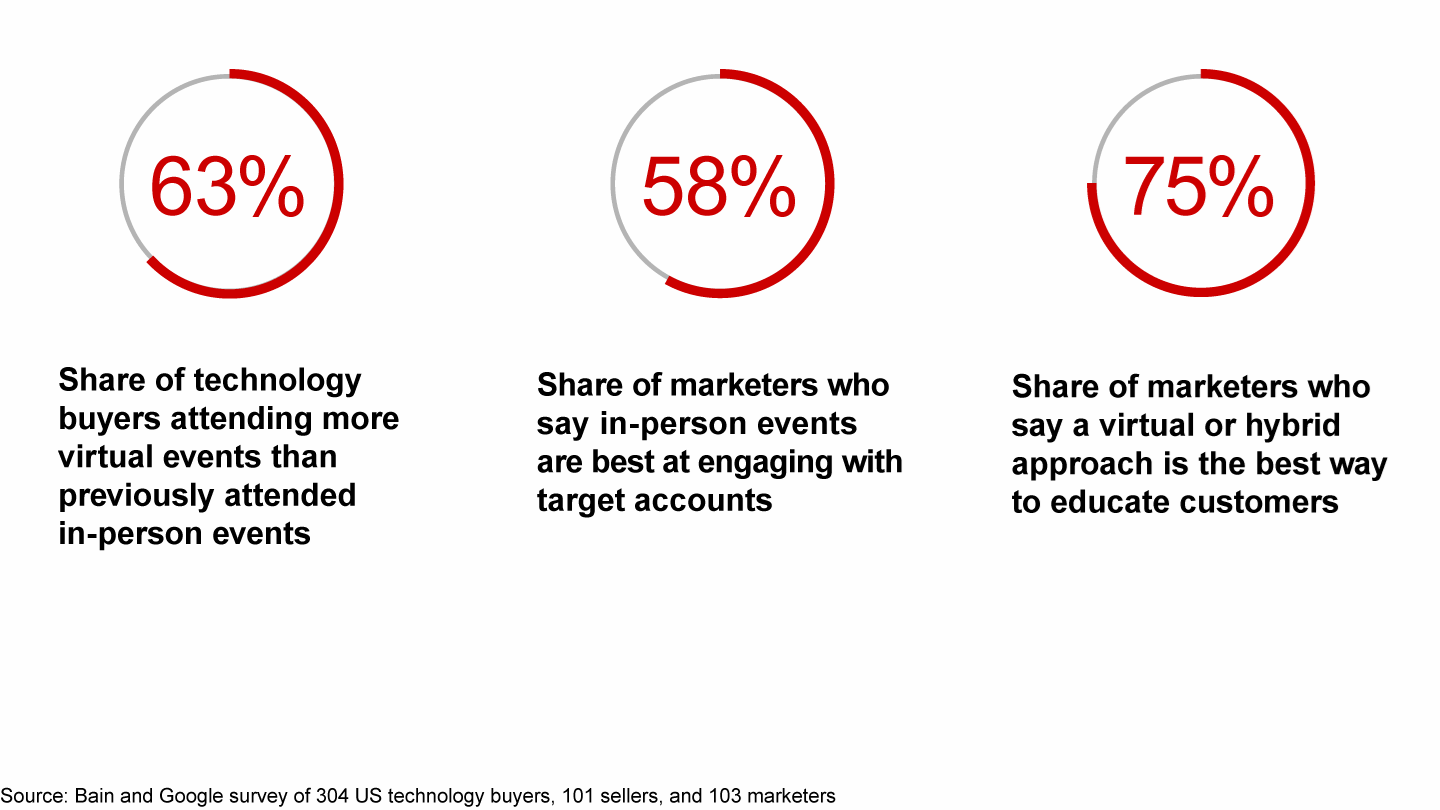Brief

People who buy technology for their organizations can access more resources, data, and informed opinion than ever. But they don’t take a linear path from reading marketing materials to engaging with a sales rep, and they often speak with contacts in their industry. Before customers surface at a vendor’s website or call center, marketers and sellers had better be prepared.
To understand the shifting dynamics of technology hardware, software, and services markets, Bain & Company and Google recently surveyed 304 US technology buyers, 101 sellers, and 103 marketers.
Their responses reveal major gaps between buyers’ behavior and sellers’ and marketers’ beliefs. The survey also confirms the effectiveness of certain strategies that respond to a more virtual purchasing environment.
Five themes stand out, as summarized in the following descriptions and charts.

How Well Does Your Company Understand and Respond to Buyer Behavior?
Take this short quiz to find out, and get practical advice for your situation.
The marketing qualified lead is dead
Since the era of vacuum tube computers, vendors have revered the qualified lead. Marketers determine which leads have a high probability of converting to real business, then hand off the qualified lead to the sales organization. But that rote motion is becoming obsolete. As the quality of digital content has improved, people who buy technology for their companies are educating themselves to a greater extent, and want more control over the sales process. By talking with industry peers, researching vendor or industry websites, and reading reviews, they become purchase-ready rather than just sales-ready. They still value interacting with sales reps, but on their own terms and timing.
Tech buyers have become far more educated before talking with a vendor


Buyers want more control over the sales process, especially in early stages


Clear pricing and tailored information rank highest among buyers’ criteria


Implications for technology providers: Make it easy and convenient for early-stage prospects to learn about how the company’s offerings deliver value. Engage purchase-ready customers earlier in the sales conversation, but make processes flexible enough that they don’t force all buyers through the same stage gates. Prospects who are not yet ready to buy could be passed back to marketing.
Myopia obscures the view of buyer behavior
Marketers’ and sellers’ historical roles have tinged their perceptions of how customers behave during the purchase process. Each overstates their own role in what customers rely on. Marketers routinely assume the company website is the most important channel, and underestimate the importance of the various paths to arrive there. Sellers overestimate buyers’ use of sales reps and channel partners. By contrast, buyers favor word of mouth early on, and use social media mainly to consume content and learn about trends and brands, rather than actively engaging with vendors.
Word of mouth is a critical source of information for buyers


Marketers and sellers each overstate their own role


Buyers use social media for purposes other than engagement with vendors


Implications: Marketers’ and sellers’ preferred channels remain important. But these groups need to understand their biases, so that they can steer resources to a broader array of channels that buyers use: industry influencers, word of mouth, and external industry websites.
Marketing is from Mars, sales is from Saturn
Sales and marketing groups often remain disconnected in their objectives and metrics. Many marketers still focus on optimizing marketing qualified leads, whereas winning marketers focus most on revenue growth—a fact that many sellers don’t recognize. Covid-19, moreover, has forced more virtual interactions, which calls for a more integrated approach. Instead of a marketing to sales handoff, the new environment calls for a consistent dialogue, with each group playing a broader role.
Tracking of different metrics varies widely among tech companies


High-performing companies have more alignment between marketing and sales groups


Implications: Marketing and sales groups must collaborate closely at each stage of the funnel. At one software-as-a-service company, the sales group contributes to marketing’s lead scoring rubric, while marketing helps shape sales’ response to potential deals. Sales can also include marketing in pipeline reviews and account discussions, and marketing can include sales on brand initiatives and channel strategy discussions. Metrics should be consistent across the marketing organization, focusing more on revenue growth.
The buyer star relies on an ensemble cast
Buying technology products has become a group activity. Most decisions involve at least five people, and many more colleagues—from IT, finance, marketing, engineering, and other functions—influence the choice. Reaching these supporting characters requires targeted ads, virtual events, or other outreach in different channels, at the right stage of the buying process. Influencers want slightly more active support from vendors, probably because they are not as informed as the decision makers.
At most companies, buying tech products is a group activity


Besides IT, many other functions influence the choice of products


Implications: Sales and marketing teams cannot rely solely on key individual relationships; they must present a convincing case to a broader group that serves as an informal committee of influencers. Each influencer may come from a different function with specific issues they want to solve. In this context, feature-oriented pitches will be less effective than solution-oriented case examples. And vendors should tailor communications to the different roles on the buyer’s side.
It takes a village to de-average events
Not only do more people influence a purchase decision, they also have more access to sales-related communications because of the proliferation of virtual events. Influencers who could not attend in-person events due to cost or scheduling constraints now have more opportunities to gather information. However, virtual events demand a more tailored approach—one version for CIOs, another for direct reports, yet another for users. And virtual events might produce more or different types of leads than in-person events.
Virtual events have become standard practice


The pandemic greatly expanded attendance at virtual events


Education is the main goal for buyers attending virtual events


Implications: Sales and marketing groups must coordinate complementary event strategies, with more early-funnel events going virtual and late-funnel events reverting to in-person. Each event should target different audiences. While greater access to events is generally beneficial, marketers should guard against event overload with potential buyers. The greater volume of inquiries that follow virtual events will demand careful vetting to select the most likely prospects.